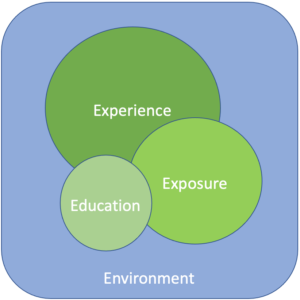31 Jul Experience shapes leadership at every level
Today’s post, Experience shapes leadership at every level, explains why growing as a leader requires on-the-job experiences that become progressively more challenging as you transition from one level to the next.
Research – and my coaching work with hundreds of clients – show the most effective way to advance your career is through on-the-job experiences that develop your competencies and confidence as you move from one level to the next.
A 2019 Korn Ferry thought leadership piece summarises research on the role of experiences as the surest way up the career ladder. Based on this compelling evidence showing that on-the-job learning accounts for some 70% of a leader’s development, Korn Ferry explains the types of experience that help contribute to you growing from one level to the next.
Putting experience into context
Experiences are one of four dimensions that combine to influence the effectiveness of a leader’s continuous learning.
 While each person learns and develops in their own particular way, the four dimensions in the diagram are universal; the size of the circles is indicative of the relative contribution of each to development (Source: Victorian Leadership Academy 2019).
While each person learns and develops in their own particular way, the four dimensions in the diagram are universal; the size of the circles is indicative of the relative contribution of each to development (Source: Victorian Leadership Academy 2019).
Experience covers what happens on the job, including the range and complexity of responsibilities, strategic projects, secondments to customers and suppliers, new product development and the like.
Exposure comprises interactions that build connections, relationships and networks. These activities expose the leader to different communities and stakeholder groups. These include industry task forces, best practice visits, attendance at senior executive meetings that are not part of the current job, and participant observation as a ‘customer’.
Education involves formal and informal programs of study whether internal or external, e.g. business schools, online courses, webinars and podcasts and conferences.
Environment is everything else that gives context to the other three Es. Internally, this includes the organisation’s values and culture, organisational structure and systems. Externally, customer trends, competitive forces and technological impacts all have an effect.
All four dimensions have an influence on how your career progresses as you move from one level to the next. The size of the circles indicates the disproportionately large impact of Experience.
Levels of leadership
First, let’s understand what each of the levels looks like.
First-level leaders usually manage a small project or functional team to achieve goals set by superiors by using the resources allocated to them. Their focus is internal, and their work involves doing as well as leading like a player-coach in sport.
Mid-level leaders manage a larger team and are responsible for delivering a department’s goals by setting out the tasks and responsibilities of the team’s members. Their focus is usually internal, and they are usually one removed from the day-to-day work, i.e. they are the coach, not a player. First- and mid-level managers typically have a short-term horizon.
Business unit-level leaders with an external focus manage a complete business unit and are responsible for serving customers, all functions and the P&L of the unit. They often ‘buy’ functions like marketing, HR and finance from corporate services. A business unit leader aligns the unit with corporate strategy. Some business units have an internal focus on serving market-facing units by, for example, providing production and logistics. Typically business unit leaders have a medium-term horizon.
Senior executives develop and direct strategies for long-term success by building defensible competitive advantage and sustainable practices while pursuing growth. They manage complex stakeholder groups and the trade-offs amongst their often conflicting interests. These executives are measured on balanced scorecards.
Transitions in leadership experience
For each of these three transitions, I now show the most powerful experiences that enable a leader to move up to the next level.
-
- From first-level leader to mid-level leader
- Managing difficult situations, e.g. addressing under-performance or redundancy
- Assuming independent responsibility, e.g. for financial reporting
- Dealing with low EQ peers
- End-to-end management of a function, e.g. logistics, HR
- Assuming turnaround responsibility for legacy problems
- From mid-level leader to business unit leader
- Leading the strategy formulation team of the business unit
- High visibility in mission-critical projects
- Responsibility for high-risk situations, e.g. disaster recovery or product recall
- Leading critical negotiations, e.g. major supply contracts or union agreements
- Representing the organisation in the media or on public occasions
- From business unit leader to senior executive
- Setting whole-of-enterprise longer-term strategies
- Approving major buy-or-make decisions
- Motivating and leading significant start-up initiatives, e.g. new product lines or market entry
- Dealing with contentious public issues, e.g. share falls and regulator investigations
- Resilience in the face of many interpersonal challenges.
- From first-level leader to mid-level leader
Key take-out from Experience shapes leadership at every level
These (and other experiences) shape you, personally and professionally. Your success in these situations combined with your exposure and education determine how far and fast your career progresses.
I recommend integrating this framework into your development plan.
Other posts on this topic
Stepping up requires seven shifts and Three ways relationships shape your career


